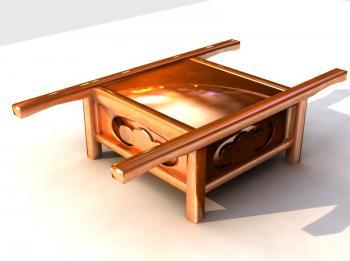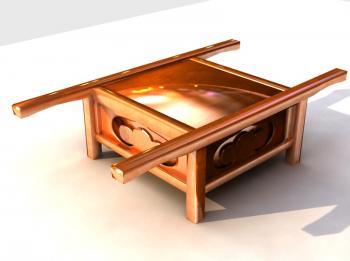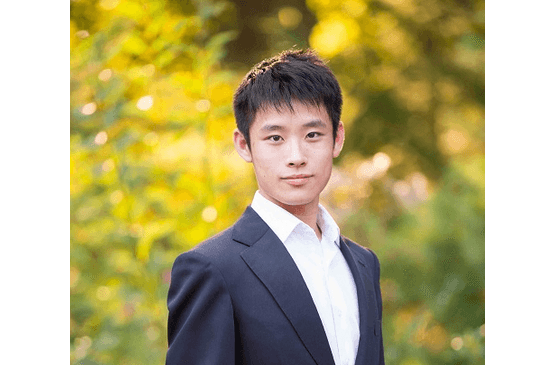Chang’an (now called Xi’an), was once the capital of the Tang Dynasty (618 - 907). It was prosperous in terms of economy and culture; moreover, it attracted many foreigners.
The 3rd International Chinese Culinary Competition, part of New Tang Dynasty Television’s (NTDTV) Global Competition Series, will hold its North America preliminary and final rounds in Times Square. The public only needs a ticket to watch the competition and taste the contestants’ competition dishes.
“The International Chinese Culinary Competition aims to revive traditional Chinese culinary techniques and methods, promote authentic Chinese culinary philosophy, and promote the exquisite traditional Chinese culinary culture,” says the competition’s Website.
In preparation for the event, Times Square will be decorated in the Chang’an way. Wei Jane Chir, artistic director of the competition, designed the structures that will be set up in Times Square by referring to paintings of Chang’an from the Tang Dynasty. Because a lot of Chinese culture has been lost, NTDTV had to find materials from all over the world in order to create the most authentic experience possible.
The roof of the structures, for example, will simulate roofs in Chang’an, with orange, the color of Buddhist Kasaya, as the main color used. Along with Confucianism and Taoism, Buddhism has had great influence in Chinese culture.
In addition, the waiters who will serve the audience at the competition will wear Tang Dynasty clothing.
“We are trying to revive and revitalize the traditional Chinese culture and introduce it to the world—not only Chinese people, but also people from other parts of the world who are here in New York,” Chir said.
New York: the Western Chang’an
New York reminds her of Chang’an, Wei Jane Chir said, because both are melting pots of many cultures.
“People regarded going to Chang’an, the capital of China, as a dream,” she said.
Paintings and sculptures from the Tang Dynasty can be seen in art museums all over the world, Chir said, and Western people are depicted in those artworks.
Tang Dynasty poet Wang Wei has written a poem about the morning court in the palace of Chang’an. The morning court was a meeting held each morning that Chinese emperors conducted with their officials to discuss state affairs. Wang said in his poem that during the morning court, envoys from different countries, along with the Chinese officials, worshiped the Chinese emperor.
“Just like everyone wants to come to New York because New York is a place full of energy, Western people traveled through the silk road to go to Chang’an. Some of them wanted to learn [from China]; some wanted to show off their talents,” Chir said.
“In the Metropolitan Museum of art, there are some sculptures—artifacts from the Tang Dynasty. At first sight you can see big ears, big eyes, and big noses—that’s Westerners. They were playing music there to attract people’s attention.”
Continued on next page
“The reason Chang’an was prosperous was because it had very liberal emperors, and the local culture was rich,” Chir said. “I think New York is like that. New Yorkers are very open. I have had this feeling since I first came here because the people here are very international.”
And it was from the cultural exchange in Tang dynasty’s Chang’an that Chinese culture has a great influence on other countries. Japanese culture, in particular, has many similarities with Chinese culture. Many of Japan’s arts and buildings resemble that of China’s in the Tang Dynasty.
“The Tang Dynasty was a golden age; everything started from there, including the tea culture,” Chir said. Now, tea has been spread all over the world and even integrated into Europe’s culture.
Chinese Culinary Arts
“Lao Zi once said, ‘Governing a big country is like cooking a small dish,’ illustrating that the highest principles of every action or thought corresponds to the Tao. The dietary and culinary principles, once exercised to the optimum, also encompass paramount principles governing heaven and earth,” the culinary competition’s Website says.
“The concept of Harmony is an important standard in Chinese traditional culinary arts. This balancing and apportioning principle can be subdivided into complementary meats and vegetables, appropriate collocation of cold and hot dishes, and different combinations of foods from different seasons.”
Among all aspects of Chinese culture, the culinary arts is perhaps the most widespread. The Culinary competition includes five categories of Chinese cuisines: Szechuan, Shandong, Cantonese, Huaiyang, and Northeastern cuisines, which are the most influential and which represent traditional Chinese culinary arts best.
Chinese cuisine emphasizes nutrition, and the concept started in the Tang Dynasty, Chir said. “Each of China’s five major cuisines have different emphases, but there is one thing in common: The food has to be fresh,” she said. “It does not rely on a lot of seasoning. Generally, it relies on your control of the timing, cutting method, and degree of freshness of the food.
“Nowadays, a lot of Chinese food has been altered, for example, they use a lot of seasoning and sauce. If the food is really cooked well, it would taste good without one having to add so many things.
“Sometimes, [altering the food] is for pleasing people. Some think the food has to be altered for Americans. If I were American, I wouldn’t be happy; I would think it is deceptive. There shouldn’t be a differentiation, cooking differently for Chinese and Americans. This is a very serious issue. Nowadays, in order to please others, in order to gain profit, many people cook without quality and principle.”
Another thing that needs to be revived from the Tang Dynasty is the beauty of the food. Everything from the Tang Dynasty was full of color because the people then emphasized artistry. So, when making food, there was a consideration of how the food was presented. Also, The Tang people were very particular about the utensils they used, Chir said. Even when they went to a picnic, they would bring a special table to put the food on.
“Not only did they care about color, but also they placed a lot of importance on texture. After so many years, people don’t seem to care anymore. They are not like the original Chinese people anymore,” she said. “Because Chinese people have been through a lot of wars and instability [in recent years], we have forgotten about this, so NTDTV is holding the competitions to revive these traditions, like martial arts, Han couture, culinary arts, etc., to present these beautiful arts again, and to revitalize them.”
The North America preliminary and the final rounds of the global competition will be held on Sept. 30 and Oct. 1 respectively. For $100-$125, one can watch the competition up-close in Times Square and taste the contestants’ dishes. For $60, one can attend a gourmet reception at 11am-2pm in Pier Sixty on Oct. 3; finalists, past year winners, and local restaurants will prepare sample food and libations. Then, at 5:30pm-9:30pm also in Pier Sixty, one can attend the award banquet where the winners will be announced; and for $275 per person or $2,500 per table, one can enjoy a 10-course dinner the winners prepare.
To purchase a ticket or for more information, please visit https://register.ntdtv.com/events/ or call 646-736-2969.
For more information about Chinese culinary culture and the five major Chinese cuisines, please visit http://culinary.ntdtv.com/en/ChineseCuisines/









Friends Read Free